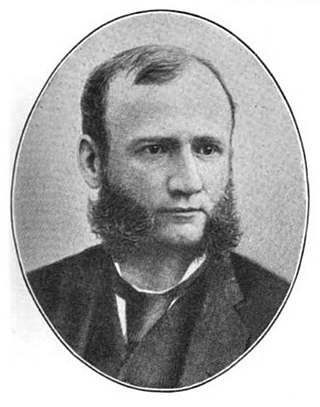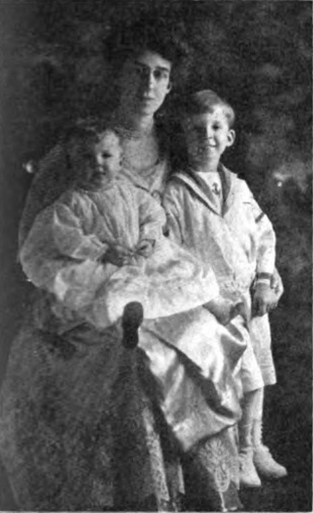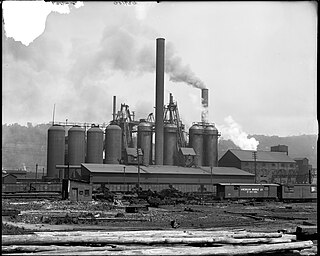
Thomas Morrison Carnegie was a Scottish-born American industrialist. He was the brother of steel magnate Andrew Carnegie and co-founder of the Edgar Thomson Steel Works.

Carnegie Steel Company was a steel-producing company primarily created by Andrew Carnegie and several close associates to manage businesses at steel mills in the Pittsburgh, Pennsylvania area in the late 19th century. The company was formed in 1892, and was subsequently sold in 1901 in one of the largest business transactions of the early 20th century, to become a major component of U.S. Steel. The sale made Carnegie one of the richest men in history.

The Jones and Laughlin Steel Corporation, also known as J&L Steel or simply as J&L, was an American steel and iron manufacturer that operated from 1852 until 1968. Beginning as the American Iron Company, founded in 1852 by Bernard Lauth and Benjamin Franklin Jones, a few miles south of Pittsburgh along the Monongahela River. Lauth's interest was bought in 1854 by James Laughlin. The first firm to bear the name of Jones and Laughlin was organized in 1861, and headquartered at Third & Ross in downtown Pittsburgh.

The Edgar Thomson Steel Works is a steel mill in the Pittsburgh area communities of Braddock and North Braddock, Pennsylvania. It has been active since 1875. It is currently owned by U.S. Steel and is known as Mon Valley Works – Edgar Thomson Plant.

The US iron and steel industry has paralleled the industry in other countries in technological developments. In the 1800s, the US switched from charcoal to coal in ore smelting, adopted the Bessemer process, and saw the rise of very large integrated steel mills. In the 20th century, the US industry successively adopted the open hearth furnace, then the basic oxygen steelmaking process. Since the American industry peaked in the 1940s and 1950s, the US industry has shifted to small mini-mills and specialty mills, using iron and steel scrap as feedstock, rather than iron ore.

Carnegie Brothers and Company, Ltd. was created by the consolidation of the steel businesses owned by Andrew Carnegie in the early 1880s. Those steel and coke works that were consolidated were:
Jennie Bradley Roessing was a leader in Pennsylvania's women's suffrage movement during the early 1900s. She was an active participant in the women's suffrage movement and various Pittsburgh-area organizations.

James Gayley was an American chemist and steel metallurgist who served as managing director of the Carnegie Steel Company, and as the first vice president of U.S. Steel from 1901 to 1908. He is credited with many inventions which greatly improved the fields of steel and iron making. For his contributions in the field of metallurgy, he was awarded the Elliott Cresson Medal in 1909, and the Perkin Medal in 1913.

The Lithgow Blast Furnace is a heritage-listed former blast furnace and now park and visitor attraction at Inch Street, Lithgow, City of Lithgow, New South Wales, Australia. It was built from 1906 to 1907 by William Sandford Limited. It is also known as Eskbank Ironworks Blast Furnace site; Industrial Archaeological Site. The property is owned by Lithgow City Council. It was added to the New South Wales State Heritage Register on 2 April 1999.

Hannah Jane Patterson was an American suffragist and social activist. She was a key member of the women's suffrage movement in Pennsylvania and worked for the National American Woman Suffrage Association. During World War I Patterson was a member of the Woman's Committee of the Council of National Defense. For her service, she was awarded with a Distinguished Service Medal. Patterson graduated from Wilson College and studied at both Columbia University and the University of Pennsylvania.

This is a timeline of women's suffrage in Pennsylvania. Activists in the state began working towards women's rights in the early 1850s, when two women's rights conventions discussed women's suffrage. A statewide group, the Pennsylvania Woman Suffrage Association (PWSA), was formed in 1869. Other regional groups were formed throughout the state over the years. Suffragists in Pittsburgh created the "Pittsburgh Plan" in 1911. In 1915, a campaign to influence voters to support women's suffrage on the November 2 referendum took place. Despite these efforts, the referendum failed. On June 24, 1919, Pennsylvania became the seventh state to ratify the Nineteenth Amendment. Pennsylvania women voted for the first time on November 2, 1920.

The women's suffrage movement in Pennsylvania was an outgrowth of the abolitionist movement in the state. Early women's suffrage advocates in Pennsylvania wanted equal suffrage not only for white women but for all African Americans. The first women's rights convention in the state was organized by Quakers and held in Chester County in 1852. Philadelphia would host the fifth National Women's Rights Convention in 1854. Later years saw suffragists forming a statewide group, the Pennsylvania Woman Suffrage Association (PWSA), and other smaller groups throughout the state. Early efforts moved slowly, but steadily, with suffragists raising awareness and winning endorsements from labor unions.

Jennie Eliza Kennedy was an American clubwoman and suffragist. Kennedy was one of the activists that helped create the "Pittsburgh Plan" as a women's suffrage strategy.

Lucy Kennedy Miller (1880–1962), also known as Mrs. John O. Miller, was a prominent 20th-century American suffragist who became the president of the Equal Franchise Federation of Pittsburgh, Pennsylvania and the first president of the Pennsylvania League of Women Voters (PLWV). In 1919, the League of Women Citizens of Pennsylvania called her "the woman to whom, more than to any other" was "owe[d] the triumph of" women's suffrage in the Commonwealth of Pennsylvania.

Eliza Kennedy Smith, also known as Mrs. R. Templeton Smith, was a 20th-century American suffragist, civic activist, and government reformer in Pittsburgh, Pennsylvania. Upon her death in 1964, The Pittsburgh Press described her as "a relentless, tenacious watchdog of the City's purse strings" who "probably attended more budget sessions over the years than anyone else in Pittsburgh either in or out of government".

Isabella Furnace was a collection of blast furnaces built in 1872 in Etna, Pennsylvania, across the Allegheny River from Pittsburgh.

Lucy Furnace was a pair of blast furnaces in Pittsburgh, Pennsylvania, on the Allegheny River in Lawrenceville. The furnaces were part of the Carnegie Steel Company, with the first furnace erected in 1871 by brothers Andrew and Thomas M. Carnegie, Andrew Kloman and Henry Phipps Jr. This furnace was the first one built new by the Carnegies. In 1877 a second furnace, Lucy No. 2, was built at the same site.
Mary "Molly" Ella Bakewell was an American suffragist, author and social activist from Pittsburgh, Pennsylvania. The eldest of three daughters in the prominent Bakewell glassmaking family, she devoted her life to advocacy and reform. Originally she was an advocate for kindergartens, as a member of the International Kindergarten Union. In the early 20th century she devoted herself to women's suffrage working with Eliza Kennedy Smith, Lucy Kennedy Miller, Jennie Bradley Roessing, Mary Flinn Lawrence and Hannah Patterson. Later in life she attended Hartford Theological Seminary and took up the cause of female clergy. She also authored three books and an unpublished manuscript.
















